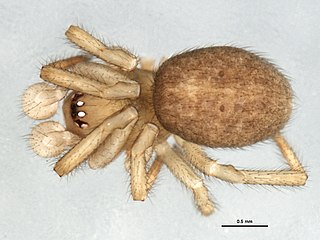
Amaurobiidae is a family of three-clawed cribellate or ecribellate spiders found in crevices and hollows or under stones where they build retreats, and are often collected in pitfall traps. Unlidded burrows are sometimes quite obvious in crusty, loamy soil. They are difficult to distinguish from related spiders in other families, especially Agelenidae, Desidae and Amphinectidae. Their intra- and interfamilial relationships are contentious. According to the World Spider Catalog, 2023, the family Amaurobiidae includes 286 species in 50 genera.

Callobius is a genus of tangled nest spiders first described by R. V. Chamberlin in 1947.

Amaurobius is a genus of tangled nest spiders that was first described by Carl Ludwig Koch in 1837.
Scotinotylus is a genus of sheet weavers that was first described by Eugène Louis Simon in 1884.
Spirembolus is a genus of North American sheet weavers that was first described by Ralph Vary Chamberlin in 1920.

Robertus is a genus of comb-footed spiders that was first described by Octavius Pickard-Cambridge in 1879. It is considered a senior synonym of Garritus.

Cybaeopsis is a genus of tangled nest spiders first described by Embrik Strand in 1907, and transferred from Agelenidae to Amaurobiidae by Pekka T. Lehtinen in 1967. They all occur in North America except for three species; C. lodovicii, C. theoblicki and C. typica.

Zanomys is a genus of North American tangled nest spiders first described by R. V. Chamberlin in 1948.

Wadotes is a genus of North American funnel weavers first described by R. V. Chamberlin in 1925.

Blabomma is a genus of araneomorph spiders in the family Cybaeidae, and was first described by R. V. Chamberlin & Wilton Ivie in 1937. Originally placed with the funnel weavers, it was moved to the Dictynidae in 1967, and to the Cybaeidae in 2017.

Emblyna is a genus of cribellate araneomorph spiders in the family Dictynidae, and was first described by R. V. Chamberlin in 1948.

Phantyna is a genus of cribellate araneomorph spiders in the family Dictynidae, and was first described by R. V. Chamberlin in 1948.
Tivyna is a genus of cribellate araneomorph spiders in the family Dictynidae, and was first described by R. V. Chamberlin in 1948.
Nodocion is a genus of ground spiders that was first described by R. V. Chamberlin in 1922.
Arcuphantes is a genus of dwarf spiders that was first described by Ralph Vary Chamberlin & Vaine Wilton Ivie in 1943.
Coloncus is a genus of North American dwarf spiders that was first described by Ralph Vary Chamberlin in 1949.
Oreonetides is a genus of dwarf spiders that was first described by Embrik Strand in 1901.
Phruronellus is a genus of North American araneomorph spiders first described by R. V. Chamberlin in 1921. Originally placed with the Liocranidae, it was moved to the Corinnidae in 2002, and to the Phrurolithidae in 2014.

Phrurotimpus is a genus of araneomorph spiders first described by R. V. Chamberlin and Wilton Ivie in 1935. The name is a compound adjective meaning "guarding the stone". Originally added to the Liocranidae, it was moved to the Corinnidae in 2002, then to the Phrurolithidae in 2014. They have red egg sacs that look like flattened discs, often found on the underside of stones.











